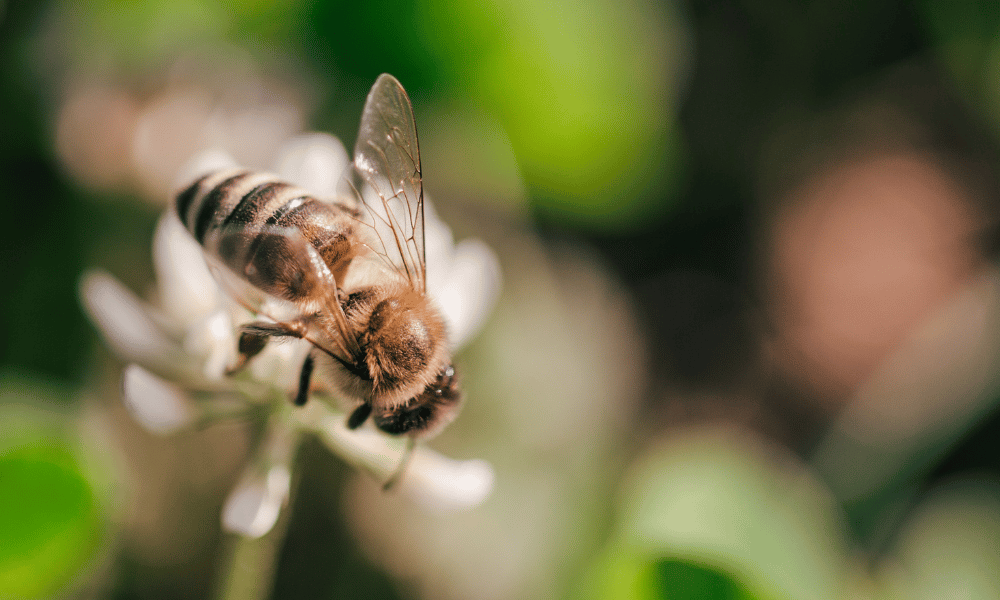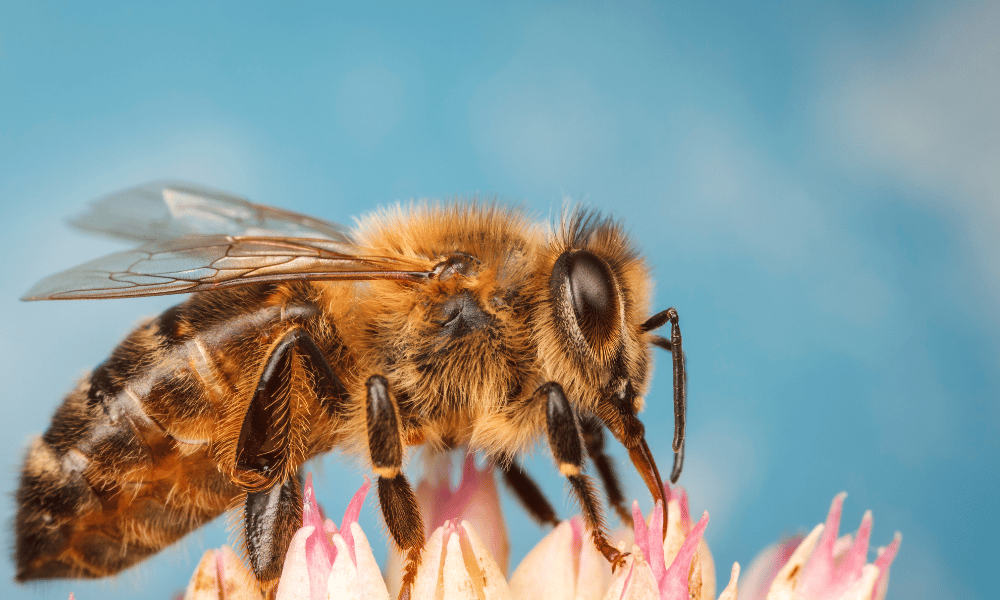Bees have a complex and unique anatomy. Between legs specially designed to collect pollen, five eyes, and a double set of wings, bees are truly an anatomical marvel. But what does the inside of a bee consist of? We already know that bees do not have lungs, but do bees have bones?
Bees do not have any bones, veins, or lungs. All of their internal organs float within a blood and lymph fluid mixture called hemolymph. The body of the bee holds its shape with the support of an exoskeleton.
Do Bees Have a Skeleton or Exoskeleton?
Bees do not have bones. The rigid support system that our skeleton provides us on the inside, is replaced with an exoskeleton in the case of the bee.
Bees have a unique exoskeleton that allows the bee to remain one size as an adult bee. Bees do not shed or outgrow their exoskeletons.
The exoskeleton is made up of a lightweight material called chitin. Chitin is made of glucose. One of the advantages of chitin in an exoskeleton is that the material can hold a lot of weight while remaining incredibly light for the bee.
This allows the bee to fly easily.
Bees’ exoskeletons are rigid and also covered in a wax-like material. This allows the bee to protect its vital organs and interior structures, like tracheas and air sacs which allow the bees to breathe.

Are Bees Vertebrates or Invertebrates?
Since bees do not have bones, they do not have a backbone, therefore, they are considered invertebrates. Invertebrates are animals that do not have a spinal column or backbone.
Invertebrates make up more than 95% of the ecosystem today and are important to maintaining and sustaining life on the planet.
Vertebrates are animals that do have a central backbone or spinal column. These tend to be animals that we think about often. Dogs, horses, birds, and humans are just a few of the many species that are considered vertebrates.
Since vertebrates have a spinal column, they have a spinal cord that connects to a functioning brain. They also tend to have a well-developed parasympathetic and sympathetic nervous system.
Want to Attract Bees to Your Garden?
We’ve Put Together a Complete Guide to Attracting Bees to Your Garden Including Our Top 14 Plants You NEED to Have in Your Garden:
Do Bees Have A Central Nervous System?
Bees are among some of the invertebrates that do have a central nervous system. Though much simpler than that of a human, a bee’s central nervous system consists of a brain, a central nerve cord that runs the length of the bee, ganglia, and lateral nerves.
The bee’s brain is made up of many different parts, much like the human brain.
There are sections of the bee’s brain that help them identify what they are seeing, process data received from their nerves, and parts that send out nerve signals that tell a bee what part of their body to move.
Bees have even been known to pass tests and learn cool tricks when scientists have set up experiments to test a bee’s brain power (you can check out some of the studies here).
Ganglia are paired and run down the back of the bee along the central nerve cord. These tissues are specially designed to be able to sense and interpret the information that comes from both the brain and the lateral nerves that they are connected to.
The ganglia are unique to the section of the body where they are located in.
Can Bees Feel Pain?
Bees are complex creatures. They have an ingrained set of social skills to help keep their colonies alive and thriving, have a brain and central nervous system that helps them learn new things and have five eyes that help them navigate the world.
But with all these unique senses and abilities, how close are bees to feeling human emotions? Can bees feel pain?
The answer is simply, yes and no. Bees can register a painful incident is happening and adjust, but they may not feel the actual pain associated with it.
Detecting pain or an issue with the bee is different from feeling the sharp jar of pain in the body.
Scientists have noted and watched bees adjust to their surroundings and move away from harmful or painful stimuli, but they did not seem to register that pain was held in their bodies.
Bees do not have blood as humans do. Instead, their body is filled with a substance called hemolymph which tends to be colourless.
Yes, bees have a heart. This pumps oxygen around their bodies and keeps them alive – much like a human heart does!
Summary
Bees do not have bones nor do they have an internal skeleton that holds their bodies up or provides a structure for their bodies.
Instead, bees have an exoskeleton made of chitin, a lightweight material consisting of glucose. Between layers of the exoskeleton, is a wax-like substance that helps the bees stay rigid but still move.
Although bees do not have vertebrae or backbone, the structure they do have is a central nerve cord. This cord connects the brains of the bees to the rest of the lateral nerves in their body.
Even with a simplified central nervous system, the bees are able to live and thrive well in colony life.
The central nervous system of a bee also allows the bee to understand its surroundings. Scientists believe that although bees recognize painful stimuli, they cannot actually feel pain. They simply react to the environment and adapt to the current situation.
Bees are miraculous and unique creatures with a huge importance on the planet. As some of the best and most vital pollinators, bees provide a great service to the world’s food supply.







